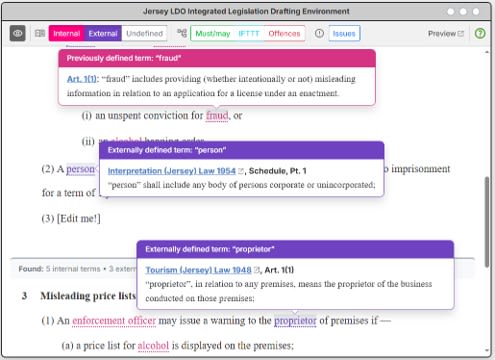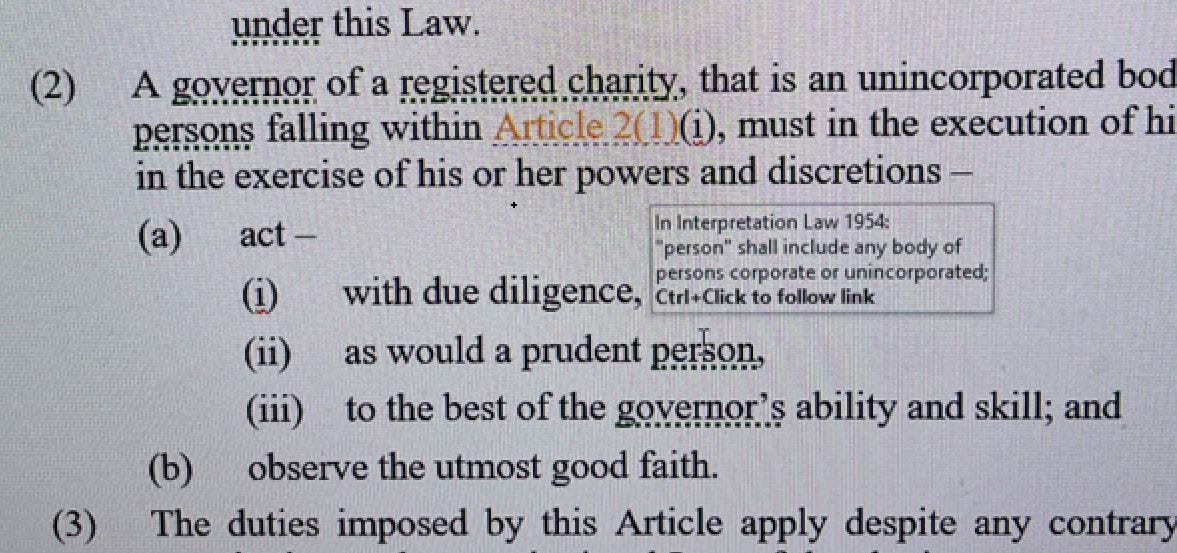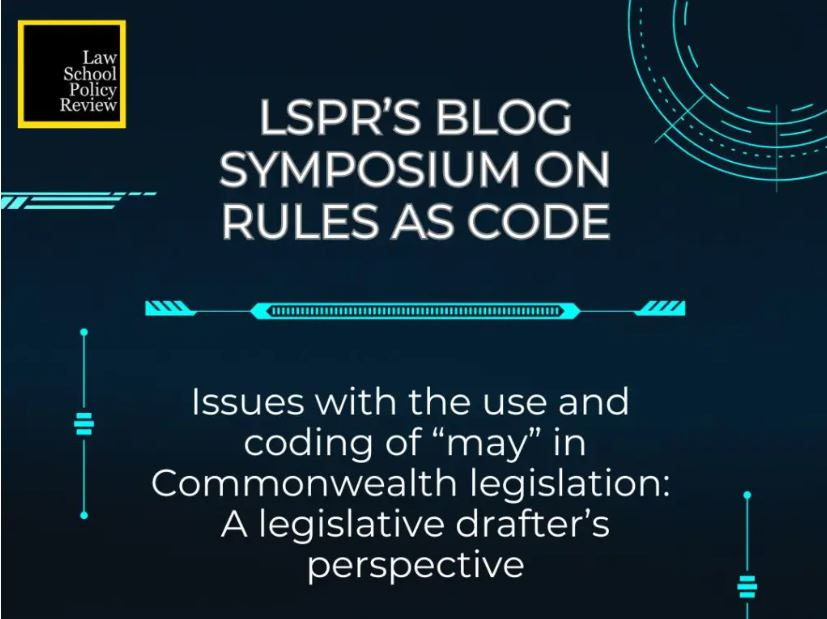Logic maps, definition pop-ups, "may"/"may not", and more
What we are up to in 2025
Some recent events
CALC/PCC Perth 2025 conference - see our pre-recorded presentation and slides on the work we have done with definition pop-ups in Word on definitions and our work with Singapore so far. There was a useful Q&A session afterwards. Also look out for the presentation by Michael Fairweather “Legislative Quality Assurance by Computer Simulation” (we will post a link in Notes here when it is available).
Law School Policy Review’s Blog Symposium on “Rules as Code” – organised by students from the National Law School of India University, Bangalore – several blog articles, interviews and a panel discussion, including from us (see below).
See also Rules as Code Guild - an excellent way of keeping up with other developments. They have monthly “Townhall” meetings with presentations by people working in the field. Their YouTube site has videos of previous presentations to catch up with. Do consider joining or attending the Townhalls.
Work with Singapore – visualising the logical structure of legislation
Thanks to our funding from the Jersey Legal Information Board we are working till June 2025 with the Centre for Digital Law at Singapore Management University on their L4 DSL - a “domain specific language” (or DSL) for law. We are looking at several ideas to see what L4 can do with our project - to code legislation in a way that is human-readable and gives visualisations - see our outline plan.
We covered some of that work towards the end of our presentation and slides in Perth (above). But for more detail see this demonstration video of using Singapore’s L4 to give ways to visualise the logical structure of the legislation we draft (& using Excel to give reliable answers).
The video demonstrates that with s1(1) British Nationality Act 1981, which is the provision that Bob Kowalski used in the experiment that kicked off computational law in the 1980’s – see also his analysis of s1 in the 1990’s.
The video first shows how we use Excel to split the legislation’s text into cells, and how that means we can make Excel ask questions and give answers about how it applies to scenarios.
The video then shows how L4 can be used to automatically draw a map of the and-or logical structure of the section, in which you can follow different paths from left to right to see all the possible combinations. It also demonstrates how the L4 encoding is readable by legislative drafters, and how L4 offers other benefits like -
being able to see where you have used the same expression (which should have the same meaning, even if you have not defined it), or
being able to use a pop-up on a defined term to take you to its definition (see notes in this post about defined term popups in Word and web).
Using hyperlinks more fully: IDs, x-refs, definitions
We are also working on our Word and web versions of the text of legislation, to give rollover popups for each instance of a defined term, linking back to its definition, as we previously illustrated in our interactive mock-up of a drafting tool.
Better links can be driven by better IDs. Hamish Fraser sent a Love letter to Parliamentary Counsel of the World (& some sequels, including “Happy Valentine's Day, Nerds 💌”).
The idea is that every paragraph of text should have its own unique ID which captures the structure (of sections & sub-sections, etc.) in a human-readable way. Once you do that, unexpected possibilities open up.
Hamish worked in Syncopate to make DocRef with nested, understandable & manageable IDs like –
“P2-S10-s65-l1-a-ii” for reg 65(a)(ii) in Subpart 10 of Part 2
In Jersey, our innovator & Word-wrangler Kate Hannah (former CALC Secretary, previously at NSW PCO) is developing a Word version of the IDs, but using Article/section and below (not Parts), like –
“art_18_p_2_sp_b_cl_iii” – for Art 18(2)(b)(iii)
Once we have these IDs, it is possible to mark up defined terms so that the definition pops up when you move the mouse over it, with a link to the definition provision. That can apply to definitions within the same piece of legislation (we have now seen Kenya’s planned new site will do this). But it can also apply to the definitions in your Interpretation Act/Law (and in other legislation under which this legislation is made, if definitions flow down that way in your jurisdiction). In Jersey we are working on making this available in our Word drafts (we do not have an XML editor), and it should then feed automatically into the html for our web pages (& to a more limited extent into our automatically-produced pdfs for our website).
Drafters tend to complain that nobody reads our Interpretation Acts/Laws, but then we never mention those Acts in our drafts of other Acts (NSW does, but only in notes), so we can hardly be surprised.
These popups are a way to avoid having to add explanatory/speculative text, while still being able to help readers who do not know they are meant to hunt for a definition provision and have never heard of the Interpretation Act/Law.
Having all the defined words linked might look a bit busy, so it might be useful to be able to toggle the links on & off, but most people are used to using Wikipedia which is full of links in this way. And it is just us catching up with what the web was originally for (see Leon’s article on hyperlinks for more detail) – it does seem remarkable that we have got away for so long without doing this.
Using “may” and “may not”
For the LSPR RaC Symposium (see above) we wrote a blog post “Issues with the use and coding of “may” in Commonwealth legislation: a legislative drafter’s perspective”. It looks at lessons that legislative drafters can learn from formal logic and computing, and lessons RaC developers can learn from legislative drafters –
improving legislative drafters’ use of "may", and
making the logical structure of “may” computer-readable.
This builds on our previous work about “may” –
Problems with “may”: A case-study from our work on appeal/review provisions – you could avoid using “may” – be aware of that & ensure when you do use “may” its purpose & effect are clear to the reader;
Section 4 “Ensuring ‘may’ works properly” in Digitising legislation: progress and prospects (in “Legislating for risk and precaution”, Black & Moloney, forthcoming).
We have also been looking at the problems involved in “may not” and “may…only”. The way we use “may do X” means we always imply “may choose to do or not do X”. Then “may not” risks confusion with “may not-do X” (when instead it normally means “not-may do X”, as in it is not the case that the person may do X).
Sometimes “may” is used for permission. In Commonwealth legislation that would be as an exception to a prohibition (“must not”). In those cases “may not” is negating that permission, usually as an exception to the exception. That could be expressed as “must not”, but only if you are not repeating the same prohibition. That means it is often better expressed by some other way of carving out the exceptions (possibly without using “may” in the first place).
Sometimes “may” is used to give a power. In Commonwealth legislation that normally means that if the person does what they “may” then someone else must (or must not) do something else (for example - if the enforcement officer serves a notice that they may serve, the recipient must not contravene the notice). In those cases “may not” is negating that power, usually as an exception, but “must not” would not capture the intended effect. Instead it might be better to consider framing the exception in terms of validity/effect, or as a simple exception. An example would be “(2) An aggrieved person may appeal to the Tribunal within 20 days after a decision under sub-section (1)”, rather than “(2) An aggrieved person may appeal to the Tribunal against a decision under sub-section (1). (3) An appeal may not be made more than 20 days after the decision”.
While “may not” might sometimes be the clearest way to express one of these for a human reader, “may…only” is almost always both troublesome and avoidable. But we are still working on that.
Team members
We have refreshed our “team” page to show new & old members – it shows the wide range of perspectives and experiences that have contributed to our work – many thanks to everyone involved.
As part of JLIB’s funding for the Singapore work, JLIB have taken on 2 new assistants to work part-time with us on the project – Garret Lyne and Stephen Ausden.
Meanwhile, Leon Qiu has made a welcome return as a part-time volunteer.
See our team page for more details.






